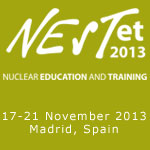

PIME 2013: Communicating Nuclear
The PIME (Public Information Materials Exchange) Conference is an ENS conference that is held each year and dedicated to communications in the nuclear field. Its objective is to promote the sharing of communications specialists’ strategies and good practices in order to increase the global acceptance of nuclear energy. Indeed, the conference format, with its combination of plenary sessions and workshops focused on specific topics, facilitates the exchange of information, expertise and experience between nuclear communicators from many different countries and organisations and with a variety of backgrounds.
PIME 2013 took place from 17 to 20 February 2013 in Zürich, Switzerland, at the Renaissance Hotel. This was very special PIME as it marked the 25th anniversary of the conference and was jointly organised with FORATOM. While the main thrust of the 2012 conference was a focus on communications issues surrounding the Fukushima crisis, this year’s conference reverted to a range of more general topics, including: Communications in Nuclear over the past 25 years, Reputation Management, Risk Perception and Communication in Nuclear R&D.
Monday 18 February 2013
The opening session of PIME 2013 kicked off with a welcoming speech from Dr. Marco Streit, the President of ENS. Dr. Streit recalled the role that Zürich has played in the past not only as a financial center but also as a center of excellence in research and the promotion of quality of life. For this purpose, he noted the link between famous scientists - Felix Bloch, the Swiss co-recipient of the Nobel Prize for Physics in 1952; Albert Einstein, the German/Swiss/American recipient of the Nobel Prize for Physics in 1921 and Paul Scherrer, a Professor at the ETH Zürich and the “father of the Swiss nuclear programme” - and writers like Thomas Mann, the German author who won the Nobel Prize for Literature in 1929. Dr. Streit then highlighted the theme of PIME 2013: risk perception and communication.
The opening was followed by a presentation on the host country by the President of the Swiss Nuclear Society, Johannis Nöggerath. Dr. Nöggerath underlined the efforts made in nuclear communications since the Tchernobyl disaster. However, he pointed out the generalised media bias against nuclear power that emerged in Switzerland after the Fukushima disaster. He also mentioned the general lack of technical differentiation that is made between the Fukushima
Daiichi NPP and other NPPs around the world.
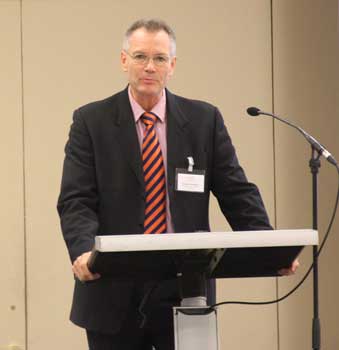
Dr. Nöggerath
This presentation was followed by the first plenary session introduced by Roland Bilang, Secretary General of the Swiss Nuclear Forum. The topic was: Communication over the past 25 years.
Bruno Pellaud, the former Deputy Director of the IAEA and a former President of the Swiss Nuclear Forum, started by explaining the specifics of nuclear communications and in particular the gap that exists between technical facts and public perception. Dr. Pellaud noted how the opponents of nuclear power are well organised, stressing that the nuclear community needs to match their effectiveness. He also remarked that nuclear opponents are generally, oddly enough, considered to be “conflict-of-interests-free.”
Ann MacLachlan, Chef de Bureau of the European office of Platts Nuclear Publications, in Paris, shared her experiences as a seasoned journalist who has reported on nuclear news for nearly 40 years. She underlined the change in paradigm brought about by new communications technologies – especially the necessity to be always faster. She commented that, in our day and age, this has encouraged journalists to sometimes sacrifice factual verification and precision for speed.
Hans Codée, the Managing Director of COVRA (the national waste management company in the Netherlands), explained the importance of transparency in matters of waste management. He presented COVRA’s activities, including the HABOG surface storage facility for high-level-waste (HLW), whose orange painted façade will deliberately be painted in progressively lighter colours over the decades to symbolise the decay of radioactive products. Dr. Codée also showed the need to make buildings enjoyable and accessible to the public through appropriate lighting (instead of the more common «bunker-type» building) and even through the housing of art exhibitions (conditions in waste storages are much similar to those that are required for storing old pieces of art). This inventive way of communicating was much appreciated by the audience.
The conference continued with the second plenary session, which had reputation management as its theme. The next speakers were introduced by Tellervo Taipale, Communications Director of FORATOM. Their presentations were as follows:
Peter Kaiser of the IAEA presented the agency’s experience with reputation management.
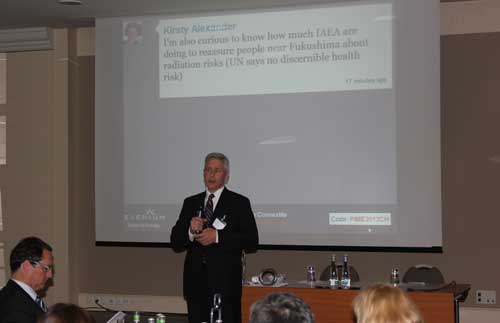
Peter Kaiser
Dr. Millicent Danker, founder of the Perception Management International Group, introduced the principle of stakeholder (any person or organisation affected in some way by a corporate decision) involvement and the importance of communicating with them.
After lunch, three more workshops tokk place in parallel. The first one, moderated by Lisa Berthelot of the IAEA and Vasiliki Tafili, of the Greek Commission of Atomic Energy, dealt with the topic of emergency communications. The second was organised by the Young Generation Network (YGN) and moderated by Andrei Goicea, Chair of ENS – YGN and Dragos Diojdescu, a professional communicator. The topic was the difficulty that engineers and communicators sometimes have when communicating with each other. The third workshop, moderated by Berta Picamal of FORATOM, dealt with the political decision-making process and its application to the field of nuclear politics.
The workshops were followed by the presentations of the four nominees for the PIME 2013 Award for Communications Excellence. The nominees were Forsmark NPP for their communication campaign entitled «Safety First», the Belgian Nuclear Forum for their campaign promoting direct communications with the public through the answering of their questions, the Finnish nuclear industry for the creation of a “virtual tour” tool for communicating basic knowledge about nuclear energy to schoolchildren and, finally, Paks NPP for its communication campaign on Facebook and how they successfully maintained their active Facebook fan-base.
Tuesday 19 February 2013
The second and final day of PIME 2013 started with a quick presentation of the results of the workshops on the previous day. This was then followed by the third plenary session, which focused on risk perception. It was chaired by Cora Blankendaal of NRG Communications (the Netherlands).
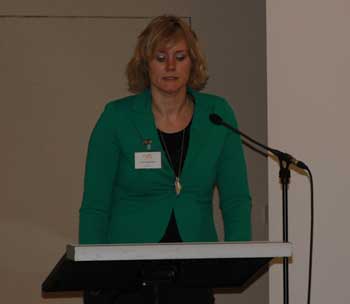
Cora Blankendaal
The first presentation was given by Ingrid Spruit and was related to the need for a proactive issues management strategy. Ingrid quoted the recent case of FedEx who were targeted by online videos showing one of their workers throwing a package over a fence. Fedex apologized less than six hours after the first posting of the video, reassuring its customers that this was contrary to its core values. This is quick response strategy is especially important with modern technologies like the Internet, where information travels fast and the period between the emergence of an issue and the release of information to the public is often very short. To limit the loss of trust in such cases she advocated the use of social networks to build communities and community managers to respond directly to people’s inquiries.
Next up, Phil Davies’ gave a presentation on how to engage stakeholders in communications activities relating to waste management. Phil insisted on the necessity of very personalised communications with local residents, with the objective of encouraging and maintaining a personal relationship and of earning the public’s trust. As was mentioned in earlier topics, he also recalled the need to listen to the people’s concerns and fears. He gave a simple example of how when people complained that a pole belonging to a construction machine did not fit the landscape the construction company simply had it painted in another color, thereby solving the issue.
After a quick coffee break, the second workshop session started. Once again, there was a choice of three for participants to choose from. The first one was moderated by Rémy Le Champion (a professional journalist and media trainer) who provided media training and gave guidance on the difficult art of passing a given message through mass media and all the associated risk of misinterpretation.
The second workshop was organised by Women in Nuclear (WiN) and moderated by WiN’s President, Se-Moon Park and the President of WiN Switzerland, Helena Loner. The topic was «How to communicate with women » and the session also examined the role of the media in the communicating about the Fukushima crisis. Presentations were given by Professor Kepplinger, of the University of Mainz; Dr. Aegaerter, of the Swiss Academy of Sciences and Professor Fischer, of the FHNW (the Technical Institute of Northwestern Switzerland). The presenters highlighted respectively the differences in media reporting in Germany, Switzerland, France and the UK. They also highlighted the importance of having women-specific communications and the strategy of exploiting them for nuclear-related topics, as well as the psychological differences that exist between men and women when it comes to risk perception.
The third and final workshop was moderated by Stephen G. Burns, of the OECD/NEA’s Legal Affairs Department. His talk concentrated on the topic of nuclear liability in the event of accidents and on the importance of effective coordination between the legal and communication departments of companies involved in such accidents.
The workshops were followed by the fourth and final plenary session, whose topic was communicating nuclear R&D. The chairman was Adrian Bull of the National Nuclear Laboratory (NNL) in the UKL.
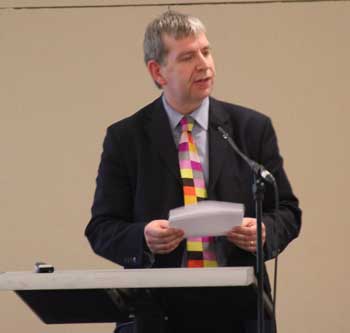
Adrian Bull
Nathalie Guillaume of the CEA presented Pimers with the challenges of communicating research and development issues, as well as the importance of reporting on technological advances that change people’s lives - some of which are not related to the nuclear industry. She gave the examples of two techniques developed at CEA for BSE detection on the one hand, and the search and rescue of people caught in avalanches on the other.
Christian Legrain of the Belgian Nuclear Research Center, SCK-CEN, then presented SCK-CEN’s experiences in this domain. He outlined how they convinced the research community that a communications policy is crucial for a research center. Scientists in the field, according to Christian, are used to being on the defensive, rather than communicating proactively and actually answering the public’s questions. He summarised very well how nuclear research is perceived by the public.
Adrian Bull presented the final part of the session by sharing the experiences of the NNL, in the UK. Much as Christian had previously argued, Adrian favoured an open and active communications policy that focuses on the positive aspects and achievements of nuclear research and counters the negative opinion of the public’s largely accident-influenced response.
Due to the absence of Jean-Pol Poncelet, Dr. Streit delivered a final speech officially closing PIME 2013. He also announced the winner of the PIME 2013 Award for Communications Excellence, which was the Paks NPP, in Hungary. The Belgian Nuclear Forum finished second, each campaign winning a little more than 30% of the vote of the conference participants.
ENS YGN Report
Boris Hombourger
Swiss Young Generation |

